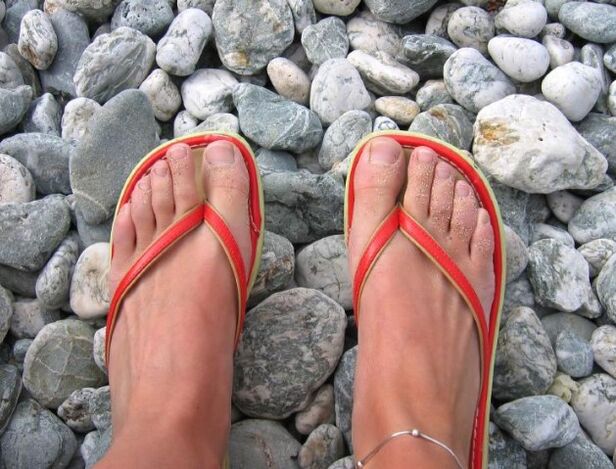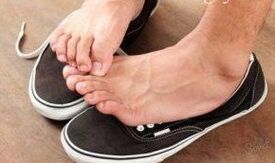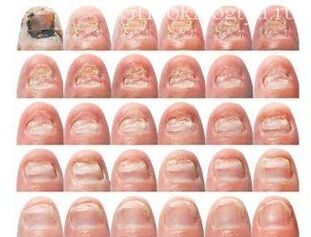Nail fungi is a very dangerous event that can move the whole nail plate. In the first stages of development, mushrooms may be invisible, but every day has a negative impact on the structure of the nail plate. We will further analyze the phase of the disease, taking into account the phase of the disease, yourself and how to treat nail fungi.

There are a number of signs that help determine the existence of mushroom lesions of the nail plate:
- The discharge of the nail - you can check when cut the edge of the nail. If the nail is not cut in the process, it is not cut, this is a clear event to see the presence of a fungi and a doctor.
- The thickening of the nail plate is mainly in the outside-hyperkeroza (compression), which will be able to disrupt the integrity of chest fibers, so it will be able to change in quality and quantity form.
- The advantage of the nail and the cutting bottom of the skin - such a phenomenon can also incite mushroom lesions, not only wearing tight shoes, but also by changing the burning space.
- Replace the color of the nail (to the brown of pale yellow) - The destruction of the active components of the nail plate occurs as a result of the folding of protein cells during the destruction.
- The presence of a white board - cork spores penetrate deep into the nail and come to the surface that is dangerous for the extensive infection of all the toes.
These are the first signs that the nail lost the health of the nail and caused the active activity of fungi:
- Bright and surface gloss;
- the mild jaundice of the nail;
- The width of the whole foot, the appearance of red dots filled with transparent fluid;
- Especially after sweating, the unpleasant smell of feet;
- To pass the skin in heels and pallets, a wide rude.
These symptoms show different problems with the legs, so the doctor's consultation is better not neglected. Early diagnosis makes the process of treatment that provides a complete recovery.

You must examine your own legs, fingers and nails to exclude or identify the availability of mungal diseases. The following indicators must be kept:
- The legs are smooth, smooth, smooth, without corn, corn, corn and seals.
- The legs are uniform without skin of skin, cracks and spots.
- There is no redness and itching between the fingers.
- Nail plate is straight, straight, transparent.
- The surface looks good with a nail bed, glow.
Deviations from the stable standards, the legs have an unpleasant manure scent, a doctor's consultation and a study to be pathogenic.
The infection of fungi can occur completely in any place, including home slices. So this happens enough:
- poor immunity that cannot limit the active reproduction of fungi;
- It is clear that the feet sweat, due to proper selected and poor quality shoes;
- With the failing of nail or cuticle's failing of cuts in the nail area;
- Lack of shoes, as well as foot hygiene;
- Frequent visit to public places with high risk of infection: city bathrooms, saunas, solarium, pool, local beach;
- Excessive use of cosmetics that cause the death of local immunity (varnishes, nail extensions, refreshing sprays and legs).
Separate types of fungus have a different period of time that the disease is not detected.
You can infect a mushroom in two ways:
- Contact - By direct contact with a healthy person with direct contact: personal hygiene, public places, wearing another's shoes.
- ATRIPTY - Infection occurs due to the active development of these fungi in the body of each person. In certain situations (for example, a sharp decline in immunity), their number increases and cannot be completely controlled by the body independently.
Most of the following categories are exposed to cork lesions:
- Children with a thin layer of skin;
- People suffering from HIV infection;
- with growing sweating of feet;
- Having chronic diseases inhibiting the immune system.

If there are above indicators, the state of nails on their feet and the situation of the stops as a whole must be watched carefully by paying the necessary attention to Hygiene.
In medicine, the concept of "fungal damage to the nail" is collective because different types of fungi can act as pathogens. Often, such fungi are found in the nails of the feet:
- Dermatophites - a group of mushrooms showing itself in the form of yellow spots or white vertical stripes. The infected nail often loses its strength and shape, and then the gap is lifeless and easily removes the nail bed.
- Maya lesions - caused by the active activity of the mushrooms of the canus. Nail itself fine, periodic roller and swelling. It can often show itself as an independent disease with colds and weakened immunity.
- Molds - mainly located on the surface of the nail, the color changes the color to greenish, brown or mind.
When the same fungi are exposed to various comprehensive factors, it is impossible to determine the commitment of a fungus, because when exposed to various aggregate factors, it can show themselves in different ways. Accordingly, it is not possible to start treatment, because all types of fungus have their own antifungal medications that negatively affect the lives of pathogens. Therefore, when the smallest deviations from the norm are diagnosed, you must consult a doctor, as well as a test for a mushroom existence.
The process of incoming a complete destruction of the nail plate is called the stages of the disease. Choose them 5:
- Infection - mushrooms enter the nail surface through cuticle to the nail bed.
- Incubation period (up to 5 months) - The activities of fungi are minimal, but it is strengthening with lightning speed when all conditions are created: immunity, moisture is not a warm environment, there is no proper hygiene. Externally, the incubation period does not show itself in any way.
- Initial stage - The number of fungi is so great that can negatively affect the vitality of the nail. The edges of the nail plate gradually turn yellow from yellow to the nail bed. The nail gets a gloomy shade, a pinky color disappears, the glow disappears from the surface. In this case, the dry skin of the toes is marked.
- The stage of the active course - the mushroom population, other nail plates, accepting disputes through the contact, reaches the maximum that allows other nail plates. Hyperkerator developed - production of keratin fibers, growing products under the influence of fungal activities. In this case, the nail is a significantly bulging, which is superior to the surface of the finger.
- The last stage - not only nail with the killing of the nail plate, but also as a result of the lesion of nearby soft tissues. There is a yellow or brown shadow on the surface of the nail, the eye sequence is recorded in the incomprehensible incision with painful feelings.
Local symptoms with large -Scale infection can also be connected:
- dysbiosis in the form of table disorder;
- increased body temperature;
- Pain in strengthening legs during movement;
- Confession link.
All the above manifestations help identify only the phase of the onychomycosis course. To determine the pathogen, you will have to receive a special analysis that provides the exact gender and the type of fungi, which provokes onychomycosis.

You need to understand that the key to successful treatment is a proper diagnosis that is impossible to make home at home. Based on the results of the analysis, only one doctor manages to determine a breed of fungi, as well as choosing the appropriate treatment.
It remains a mystery for many, does not help antifungal medication purchased in a pharmacy. There are many reasons and explanations for this. Initially, the Antifungal is selected based on the generator. Second, the treatment of fungi is a complex event consisting of:
- Local therapy - to apply antifungal medications to the surface of the nail.
- Oral antifungal tablets that can stop the development of fungi and reduce their numbers from within.
- "Forced" drugs "treated" drugs "" forced "drugs that fight their body independently.
- Fit Hygiene match - legs are washed 2-3 times a day, cool water and soap, then dried with a towel. The nail cut off every 3-5 days.
- Wear the original skin, as well as shoes made of cotton canvas.
Exclude at least one of these 5 points, the recovery process has been dragged or even failed for years. Only comprehensive treatment will allow you to easily get rid of fungi, but also rule out the risks of the relapse.
Recipes for traditional medicine, which are very difficult to treat nail fungi, are ineffective in most cases. The result will only be added to the above recommendations to combat nail cork lesions.
Thus, it is not difficult to determine the presence of a mushroom in the legs' nails. Checking the nail plate and all fingers in general, it is enough to compare the existence of a fungi. Treatment is only effective and correct when exercised under experts. Self -Mication can lead to many negative consequences for health, as well as difficult to treat the disease.
















